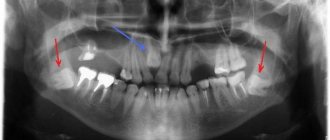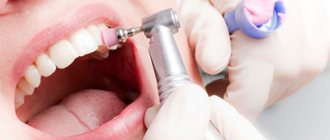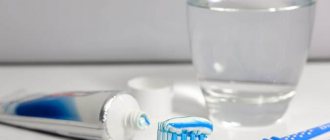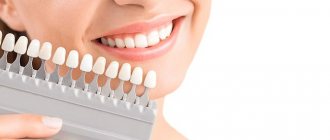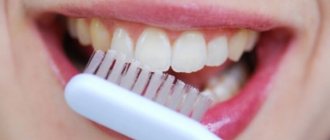Causes of discomfort
If your teeth hurt very badly after whitening, you did not eat food, did not violate the dentist’s recommendations, and the discomfort does not stop, there may be several reasons:
- an error when choosing a technique or when calculating the dosage of a lightening agent;
- using aggressive “home” remedies to enhance the effect - lemon juice, soda, salt - all these products from “grandmother’s chest” can damage the tooth or gum surface and cause infection;
- inflammation - occurs if the procedure was carried out for caries, periodontal disease, or if plaque was poorly removed;
- lightening in the presence of contraindications;
- chips, cracks in the enamel, dental pathologies can cause severe pain in the teeth after whitening, what to do in this case - the most reasonable thing is to consult a doctor;
- the presence of leaky fillings, exposure of necks and roots with advanced periodontal disease.
After lightening, you should avoid hot, cold, and spicy foods for at least a few hours - they can also cause pain.
Side effects after whitening
The appearance of discomfort during the procedure is an individual sensation and depends on many factors. We are talking about the level of tooth sensitivity, the presence of damaged areas of enamel and other problems. Today, aesthetic dentistry in St. Petersburg has many effective methods that make it possible to carry out the procedure without pain. But why does pain appear after manipulation? Our center’s specialists always explain to patients that lightening, like other medical interventions, has its consequences. They are caused by both the effects of drugs and the use of tools. Most often, clients experience the following side effects:
- Soreness of units;
- Irritation of gum tissue;
- Excessive sensitivity of teeth, when cold and hot are felt sharply;
All these problems significantly complicate the quality of life and the process of eating food.
How long does pain last?
How many days do teeth hurt after whitening is the second most popular question after the cost of the service. Everything is individual and depends on the state of health and characteristics of the human body.
When lightening is carried out correctly, the discomfort goes away immediately after the procedure - as soon as the active composition is removed from the tooth surface. But with increased sensitivity of the enamel, it can last for a short time.
The discomfort completely disappears on the second or third day. In some cases, the period may extend to 5-10 days.
How long teeth hurt after whitening is also influenced by the patient’s behavior. It is important to follow the doctor’s recommendations to speed up the recovery process and avoid consequences.
How to behave after the whitening procedure?
- What recommendations should you follow?
- Soreness after a session: what does it mean?
- Dietary advice: what is prohibited?
- What is better to forget: bad habits
After a procedure that improves the shade of the dental surface, each of us has a rational question: “What to do after teeth whitening and what is it better to refrain from so that the effect lasts as long as possible?”
At first, after exposure, teeth become especially sensitive to various negative factors; they require high-quality and constant care. There is a list of rules that must be followed. It is their conscientious implementation that ensures that the dental rows remain white for many months.
How to speed up the rehabilitation process
Main rules of behavior after the procedure:
- refuse hot/cold, sour, spicy, too hard foods for the next 3 hours;
- in the first two days, limit yourself to lukewarm soft foods;
- remove dyes – natural and synthetic – from your diet for the next couple of days if you do not want your teeth to change color;
- focus on foods high in calcium and magnesium;
- use a soft-bristled brush until the discomfort goes away;
- do not use paste containing more than 50 RDA of abrasives;
- Take complex vitamins regularly; you can additionally drink calcium and magnesium;
These recommendations will help you reduce the time during which your teeth hurt after whitening and enjoy a Hollywood smile.
What diet should you follow after teeth whitening?
After bleaching, the enamel becomes more porous, and therefore there are certain restrictions in terms of nutrition and hygiene procedures. Therefore, after the lightening procedure, adhere to the “white diet”: exclude foods and drinks that contain coloring pigments and can lead to a change in the shade of the enamel. It is worth minimizing the amount of coffee, black tea, dark vegetables and fruits consumed.
To strengthen the enamel, introduce into your diet foods that contain large amounts of calcium and fluoride: milk, kefir, cottage cheese, fish, cheeses, eggs.
It is worth excluding factors that provoke unpleasant sensations, namely, too hard food, excessively hot and cold drinks. Follow the recommendation for an average of a week or longer, if necessary. It is also better to exclude sour and spicy foods from the diet: citrus fruits, sauces, ketchup, curry and other seasonings can increase tooth sensitivity.
How to relieve or soothe pain at home
While minor pain is easy to experience and even forget about, severe pain can seriously complicate life. What should you do if your teeth hurt very much after whitening, and an immediate visit to the clinic is impossible?
At home, you can relieve pain with fluoride toothpaste, but the fluoride content must be at least 1500 ppm. This paste has high remineralizing activity; it normalizes the mineral composition of the enamel, strengthens it and eliminates microdefects. But you should not abuse this remedy either.
The same method is useful when your teeth hurt after whitening with strips, which you definitely shouldn’t do - try to relieve the pain with cold or, on the contrary, with a warm compress. Pain after the strips indicates that the procedure was performed incorrectly. The strips with the active gel were overexposed, as a result the enamel was damaged, irritation occurred, and sensitivity increased.
Pastes and rinses with chamomile, calendula, sage, and propolis will have an analgesic effect. Extracts of these herbs have an antibacterial effect and eliminate inflammation.
Prevention
If you prepare for the intervention in advance, then you won’t need to think about how to relieve pain after bleaching - it simply won’t be there or it will go away quickly.
What do you need:
- Get professional teeth cleaning. Clean itself has a brightening effect. Not much, but enough to choose the future shade, focusing on the real color of the enamel, without deposits. Tartar is removed so that it does not interfere with the reagents. Otherwise, the tooth near the gum will be darker.
- Cure all carious teeth. Caries is dangerous in principle, and before any intervention the risk of infection increases greatly.
- Undergo dental remineralization (remotherapy). Teeth are saturated with essential minerals, strengthening the enamel. The procedure is recommended, but not mandatory.
- Brush your teeth with a toothpaste for sensitive teeth for at least 2 weeks
before visiting a doctor. - Ask your doctor to numb the pain with gel or paste.
Only temporary fillings are placed before the procedure.
They are changed to permanent ones after bleaching in order to choose the shade. The most effective method of prevention is to choose a safe method
.
Dentist about safe whitening methods
Today, dentists use several methods of gentle teeth whitening:
- Laser whitening. A gentle method that removes stubborn stains. The laser beam allows you to use a gel with a lower concentration, but does not reduce its effect.
- Zoom 4. A reduced concentration of hydrogen peroxide and the use of cold light make this method one of the most gentle.
Home whitening, on the one hand, is considered safer because the concentration of acids is lower. On the other hand, it requires a responsible approach and strict adherence to instructions. Violation of the instructions leads to the fact that teeth ache and hurt after whitening.
Chemical methods are also safe if they are used by doctors with extensive practice in modern clinics where they use the latest methods. One of them is the development of American dentists - Opalescence.
Clinical methods
If after lightening your teeth become overly sensitive and susceptible to pain, this is not a reason to give up the desired dazzling smile. Teeth hurt after whitening - this can be corrected in one or several visits to the dentist with the help of fluoridation, remotherapy or remineralization with electrophoresis.
During the procedure, tissues are saturated with useful substances, strengthened, restored and increased resistance to external irritants. Therefore, even if the tooth surface is damaged during lightening, it will quickly return to normal.
We looked at the main options for when teeth hurt after whitening, how to soothe the pain and how to relieve surface hypersensitivity. But if you experience severe, persistent pain, you should immediately consult a specialist.
How to relieve pain and reduce sensitivity
If your teeth hurt after whitening, you should consult a doctor.
- It is usually recommended to take a pain reliever, such as Advil, or ibuprofen.
- Medicinal pastes are used for daily hygiene procedures. Their action is aimed at quickly restoring enamel and closing dentinal canals. Such pastes are good because they have a cumulative effect. The minimum period for their use is at least a month.
- Rinse aids should not be neglected. They are used after every meal. Use the one recommended by a specialist.
- Separately, it is necessary to say about special gels. They are used no more than 3 times a year.
- Good results are obtained by following a diet without sour, cold and hot foods.
- Do not expose your mouth to the harsh effects of smoking.
As for the duration of the period of pain, it is difficult to answer this question precisely, because everything is very individual. Usually the unpleasant sensations go away after 10-12 hours, and after three to four days, maybe earlier, sensitivity disappears. To prevent unpleasant surprises, do not forget about contraindications:
- Enamel diseases;
- Caries;
- Cracks, defects, chips on the surface of the crowns;
- Violation of sealing seals;
- Inflammation of gum tissue;
All these problems need to be resolved before the lightening session begins. Careful preparation for the procedure will help to avoid negative consequences.
Preparing for whitening
So, before you lighten the enamel you need to:
- For 15 days, use pastes that reduce sensitivity - Colgate Sensitive or
- Shown is a soft bristle brush. Before and after cleaning, desensitizing gels, for example, AcquaSeal, are applied to the crowns.
- 30 minutes before the procedure, mouth guards containing a desensitizing agent are placed on the units.
- An hour before the procedure, the patient is asked to take a painkiller.
If dental technology is not suitable for you, an experienced dentist will definitely suggest an alternative. Today it is cosmetic teeth whitening. It is safe for gums and enamel.
Choosing the optimal method
To prevent unpleasant consequences, choose gentle lightening methods. Due to the fact that special gels easily penetrate the pores of teeth and discolor pigments, the units acquire a snow-white color. Most gentle gels contain less than 0.1% peroxide. It is not harmful to mucous and hard tissues. Penetration of the substance into the surface layers of the enamel occurs due to the opening of the pores on the crowns. And the unique active component of the gel, through a certain radiation of a special lamp, has a good effect on pigments.
Opalescence whitening is performed quickly and easily. This system can lighten the enamel by 8, or even 10. It is safe, the gum tissue is not harmed, and the neutral pH of the substance does not spoil the structure of the crown. Most whitening occurs in one session, and the results last for more than 3 years.
Oral care after whitening
If you have had the procedure and the sensitivity of your teeth has increased significantly:
- in the first two days, do not consume sour, hot or cold foods; drinks and food should be at room temperature;
- use a brush with soft bristles;
- brush your teeth with gentle movements in circular lines no earlier than an hour after the procedure;
- immediately after the manipulation, you can rinse your mouth with warm water;
To restore enamel, fluoride-containing lotions are prescribed, which saturate the tissues with useful minerals, for example, Listerine Fluoride Defense. For very sensitive teeth, dentists recommend Zoom 4 technology. It is the most effective and safe. Suitable even for patients with fluorosis. The lightening result lasts up to 5 years or more.
Everything you need to know about teeth whitening
Teeth whitening is an aesthetic dental procedure that eliminates discoloration (discoloration) of teeth. This is a topic that will never lose its relevance and raises a huge number of questions.
Whitening is often confused with teeth lightening. To understand these two concepts, let's remember the reasons that result in teeth discoloration. Conventionally, they can be divided into two groups:
- External:
- plaque,
- the use of mouth rinses containing antiseptics (chlorhexidine), herbal extracts,
- drinks and food products containing food colorings (strong teas and coffee, bright juices, blueberries, cherries, red wine, soy sauce, etc.),
- some medications (antibiotics, iron supplements).
- Internal:
- general diseases of the body,
- medications (for example, tetracycline),
- caries and non-carious lesions of teeth (erosions, hypoplasia, fluorosis),
- tooth trauma (necrosis and hemorrhage of pulp tissue),
- some drugs that are used in endodontic dental treatment,
- initially dark dentin color,
- age-related changes in the structure of teeth.
Therefore, teeth whitening is the mechanical elimination of external causes of tooth discoloration (during professional oral hygiene), and whitening is the chemical elimination of internal causes (that is, due to a chemical reaction when the bleaching agent comes into contact with tooth tissue).
What are the whitening options?
There are two options for teeth whitening: home and professional (office).
Let's talk more about at-home whitening.
- Without the supervision of a dentist, the patient himself uses standard whitening trays or strips at home.
Independent use of whitening products, especially those of dubious manufacture, can often lead to undesirable consequences, such as damage to dental tissue and chemical burns to the gums and oral mucosa.
Also today on the Internet there are a lot of “recipes” for whitening using “folk remedies”.
We strongly recommend that you do not use dubious drugs and advice, but consult with a specialist!
- Under the supervision of a dentist
After a preliminary consultation, examination, determination of indications and contraindications by a doctor , impressions (impressions of teeth) are taken, and in the dental laboratory, after receiving plaster models of the teeth, individual mouth guards are made that accurately follow the contour of the necks of the teeth and gums, which ensures a tight fit and eliminates chemical burns soft tissues!
This picture shows a plaster model of teeth, on which the technician first marks the boundaries, and then applies wax in the places where the whitening gel will be located! After this, a mouth guard is made from special plates in a vacuum apparatus.
Then the patient purchases a special professional whitening gel for home use and receives all the necessary instructions for use from the doctor.
Whitening gel has a different percentage of active ingredient, which is also selected based on individual characteristics.
Important! To obtain the desired result and avoid complications, you must strictly follow all the recommendations of your doctor!
Professional teeth whitening.
We discussed options for professional whitening in previous articles.
- Whitening without the use of an activator (chemical activation only) is the Opalescence Boost system.
- Whitening using light (photoactivation) - Zoom 4.
- Whitening using laser - DoctorSmileWiser.
- Intra-canal (intra-coronal bleaching) is the whitening of endodontically treated teeth.
Which whitening is better: at-home or in-office whitening?
The question is really relevant! It all depends on how quickly and what kind of result you want to get.
Here it is worth considering the pros and cons of each type of whitening.
Homemade:
- a little cheaper than the office one,
- takes longer (2-3 weeks),
- the result is usually less pronounced,
- increased tooth sensitivity,
- Difficulties with intolerance to wearing a mouth guard may occur in patients with an increased gag reflex.
Professional:
- quickly (the procedure takes 2 hours),
- good and almost immediate results,
- less pronounced tooth sensitivity (usually only in the first day after whitening),
- expensive,
- Due to dehydration of the teeth, a brighter effect is obtained (false result), the final color stabilizes within 2 weeks.
How does teeth whitening work?
The whitening mechanism itself consists of a chemical reaction - the effect of free radicals on the tooth pigment. The active ingredient in the whitening gel is hydrogen or carbamide peroxide. When the gel is applied to the teeth and activated, the peroxide breaks down into free radicals, which, penetrating deep into the enamel, break the bonds of the pigment and increase the outflow of fluid, thereby washing the pigment out of the tooth.
Now let's leave the chemistry and see how clinical whitening works.
The first stage is professional hygiene and the prescription of remineralizing drugs for 2 weeks to prepare the enamel for the procedure.
Next, we carry out the whitening stage in the dentist’s office:
Cleaning the surface of teeth with a brush and paste
We fix a special retractor that will protect the cheeks, lips and tongue
We determine the original color and carry out a photo protocol
Next, we carefully isolate the gum tissue.
Apply whitening gel
We activate the gel in various ways, depending on the type of whitening.
- A. Only chemical activation of Opalescence Boost - the doctor mechanically activates the gel during the session.
- b. Photoactivation Zoom 4.
V. Laser activation DoctorSmileWiser
One long exposure is 15 minutes.
- Remove the used portion of the gel from the surface of the teeth. A new portion is applied and the procedure is repeated. In this way, 3-4 exposures are carried out.
- At the end of the whitening procedure, the remaining gel is removed, the insulation is removed, and a photo protocol of the result is taken.
- The final stage is the application of a special gel to reduce tooth sensitivity.
- The doctor gives recommendations
At what age can you whiten your teeth?
Teeth whitening can be performed after 18 years of age, when the processes of formation and mineralization of hard dental tissues are completely completed.
How quickly do teeth whiten?
When whitening is carried out in the dentist's office, the effect appears immediately after the procedure. It takes 2-3 weeks to achieve results at home.
How much whiter will my teeth be after whitening?
Unfortunately, it is quite difficult to guarantee a certain result! As a rule, the darker the initial tooth color, the better the predicted result. On average, teeth become several shades lighter, it all depends on the individual structure of the hard tissues of the teeth.
It is also important to understand that immediately after whitening, teeth become very bright as a result of dehydration; the final color stabilizes within 2 weeks.
Can you whiten several teeth?
Can. For example, in situations where there is partial loss of teeth or it is necessary to whiten individual teeth that have changed color after endodontic treatment.
Is it possible to whiten crowns?
No, crowns cannot be bleached. If you have crowns or fillings, they will need to be replaced after whitening.
That is why, if prosthetics are planned, we suggest first carrying out the whitening procedure, and only then installing crowns.
Do I need to do professional hygiene before whitening?
Yes! First, it is necessary to remove plaque and tartar, which will prevent the penetration of the whitening agent. Secondly, after professional hygiene, we carry out remineralization therapy for two weeks to protect teeth and prepare for whitening, and there is no point in applying strengthening drugs to plaque.
Does Teeth Whitening Increase Sensitivity?
Yes, teeth sensitivity may increase during the first time after the procedure! This is a normal reaction. To reduce and prevent sensitivity, you must follow all doctor’s recommendations and use toothpastes for sensitive teeth and remineralizing gels during this period.
Is teeth whitening harmful?
When carrying out the whitening procedure in a dental clinic or at home after consultation with a specialist, using certified materials and following all the doctor’s recommendations after the procedure, this manipulation is safe and does not have negative consequences for dental health.
If questionable materials are used, the whitening regimen is violated and the gel is used uncontrolled, or recommendations are not followed, whitening can lead to damage to the enamel, severe increase in tooth sensitivity and chemical burns of the mucous membrane.
When and who should not have teeth whitening?
There are a number of specific contraindications for the whitening procedure, which we also discussed in previous articles.
Let's remember the main ones:
- age up to 18 years,
- inflammation and gum recession,
- pregnancy, lactation period,
- increased sensitivity of teeth (is a relative contraindication and requires a specific whitening regimen),
- allergy to the components of the whitening gel,
- caries and its complications.
How long does color last after bleaching?
In fact, everything here is also very individual and depends on a person’s lifestyle: the presence of bad habits (smoking) and taste preferences (for example, eating a large amount of foods with food coloring).
If you follow all the doctor’s recommendations (especially following the “white” diet in the first 2 weeks after whitening), in the absence of bad habits, minimal consumption of coloring products and regular professional oral hygiene, the result can last up to several years.
Also, to maintain a longer-lasting effect, maintenance whitening using at-home custom trays is usually recommended.
How often should teeth whitening be done?
Everything is individual, as we already discussed above. Professional whitening can usually be done every few years.
Maintenance home whitening, on average, once every six months.
The scheme and timing are selected individually in consultation with a specialist.
How to care for your teeth after whitening?
- For the first 2 weeks, you must follow a “white diet”, that is, exclude coloring foods (strong teas and coffee, bright juices, soy sauce, red wine, cherries, blueberries, beets, etc., and the use of bright red lipstick is not recommended) .
- For the first time, avoid sour and spicy foods; they can increase tooth sensitivity.
- In-office remineralization therapy, such as Apadent Pro, is recommended to restore the enamel.
- Using toothpastes for sensitive teeth.
- Use remineralizing home gels for 2-4 weeks.
- Maintain individual oral hygiene.
Today I tried to answer the most frequently asked questions.
We strongly recommend that you do not engage in “self-whitening”, but sign up for a consultation, where we will help you choose the optimal whitening regimen, taking into account your individual characteristics and answer all your questions.
Take care of yourself and smile more often!
